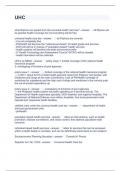TEST BANK FOR FUNDAMENTALS OF ANATOMY
AND PHYSIOLOGY 12th EDITION BY MARTINI
MARTINI
, TEST BANK FOR FUNDAMENTALS OF ANATOMY AND
PHYSIOLOGY 12th EDITION BY MARTINI
Chapter 1 An Introduction to Anatomy and Physiology
Multiple Choice Questions
1) The analysis of the internal structure of individual cells is called
A) cytology.
B) histology.
C) embryology.
D) physiology.
E) anatomy.
Answer: A
Diff: 1
Skill: Level 1 Questions: Reviewing Facts and Terms
2) The study of the general form and superficial markings of an organism is called anatomy.
A) gross
B) surface
C) systemic
D) regional
E) surgical
Answer: B
Diff: 1
Skill: Level 1 Questions: Reviewing Facts and Terms
3) The study of the superficial and internal features in a specific area of the body is called anatomy.
A) surface
B) regional
C) surgical
D) pathological
E) radiographic
Answer: B
Diff: 1
Skill: Level 1 Questions: Reviewing Facts and Terms
4) Anatomical features that change during illness are studied in anatomy.
A) gross
B) surface
C) microscopic
D) pathological
E) regional
Answer: D
Diff: 1
Skill: Level 1 Questions: Reviewing Facts and Terms
5) The study of the liver is to gross anatomy as the study of the liver cell is to
A) physiology.
B) regional anatomy.
C) cytology.
D) systemic anatomy.
E) radiographic anatomy.
Answer: C
reds
, Diff: 1
Skill: Level 1 Questions: Reviewing Facts and Terms
6) The study of the first two months of development is termed
A) histology.
B) embryology.
C) cytology.
D) pathology.
E) organology.
Answer: B
Diff: 1
Skill: Level 1 Questions: Reviewing Facts and Terms
7) The study of the function of specific organ systems is called
A) systemic physiology.
B) organ physiology.
C) cell physiology.
D) pathological physiology.
E) histology.
Answer: A
Diff: 1
Skill: Level 1 Questions: Reviewing Facts and Terms
8) Cardiovascular physiology is an example of
A) histophysiology.
B) organ physiology.
C) systemic physiology.
D) pathological physiology.
E) physiological chemistry.
Answer: C
Diff: 1
Skill: Level 1 Questions: Reviewing Facts and Terms
9) Which of the following is arranged in correct order from the most COMPLEX to the SIMPLEST?
A) cellular, tissue, molecular, system, organ, organism
B) molecular, cellular, tissue, organ, system, organism
C) tissue, cellular, molecular, organ, system, organism
D) organ, organism, molecular, cellular, tissue, system
E) organism, system, organ, tissue, cellular, molecular
Answer: E
Diff: 1
Skill: Level 1 Questions: Reviewing Facts and Terms
10) Which organ system provides support, protection of soft tissue, mineral storage, and blood formation?
A) integumentary
B) muscular
C) skeletal
D) nervous
E) endocrine
Answer: C
Diff: 1
Skill: Level 1 Questions: Reviewing Facts and Terms
reds
, 11) Which organ system transports nutrients, metabolic wastes, gases, and defense cells?
A) cardiovascular
B) digestive
C) muscular
D) respiratory
E) urinary
Answer: A
Diff: 2
Skill: Level 1 Questions: Reviewing Facts and Terms
12) Which organ system includes the spleen and the tonsils?
A) digestive
B) endocrine
C) nervous
D) cardiovascular
E) lymphatic
Answer: E
Diff: 2
Skill: Level 1 Questions: Reviewing Facts and Terms
13) The kidneys and ureters are organs of the system.
A) endocrine
B) digestive
C) respiratory
D) urinary
E) lymphatic
Answer: D
Diff: 1
Skill: Level 1 Questions: Reviewing Facts and Terms
14) The pituitary gland and thyroid gland are organs of the system.
A) endocrine
B) cardiovascular
C) respiratory
D) lymphatic
E) digestive
Answer: A
Diff: 1
Skill: Level 1 Questions: Reviewing Facts and Terms
15) Which organ system removes carbon dioxide from the bloodstream?
A) cardiovascular
B) lymphatic
C) respiratory
D) digestive
E) endocrine
Answer: C
Diff: 1
Skill: Level 1 Questions: Reviewing Facts and Terms
reds






